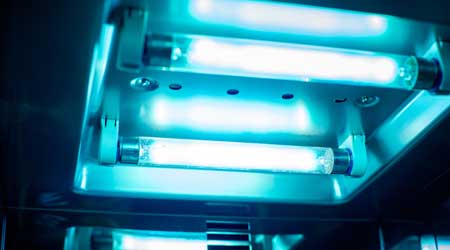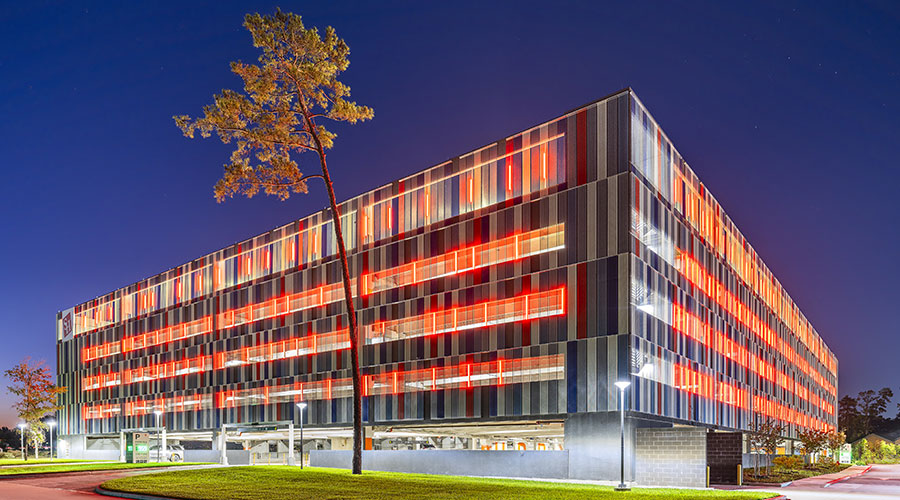COVID-19 Decontamination: How to Harness UV-C Light to Disinfect Facilities
Ultraviolet germicidal irradiation is a tried-and-true disinfection technique. But caution is required for use in facilities. Here's what you need to know.
By Chrysanthi Stockwell and Foad Shafighi
Difficult challenges caused by the COVID-19 pandemic have been the order of the day in 2020. However, current circumstances are spurring the innovation of therapies and techniques that are changing global approaches to many fields, including the decontamination of the built environment. As is often the case with transformative technologies, building blocks that have been available for decades are being assembled in inventive ways to create tools uniquely suited to fight the spread of the coronavirus.
Ultraviolet (UV) light, invisible to the human eye, exists on the electromagnetic spectrum between X-rays and visible light. There are three types of UV light that are classified by wavelength from longer to shorter – UV-A, UV-B, and UV-C. Light-based disinfection, in the form of UV-C irradiation, has been part of standard protocol for sterilizing hospital spaces and scientific laboratories for decades and has even become widely used as a replacement for chlorine in purifying municipal drinking water supplies.
Ultraviolet germicidal irradiation (UVGI) is a disinfection method that uses short wavelength ultraviolet (ultraviolet C or UV-C) light to kill or inactivate microorganisms by destroying nucleic acids and disrupting their DNA, leaving them unable to perform vital cellular functions. UVGI is used in a variety of applications, such as food, air, and water purification.
Because of the risks of exposure for human cells, UVGI is especially useful in unoccupied spaces and is already used in some offices and factories after employees have left for the day. Much of the recent innovation has been aimed at designing systems to use UV-C safely for sanitizing the air and surfaces of spaces that are filled with people. Some possible target locations include high touch and traffic areas in:
- Hospitals
- Fitness centers
- Warehouse distribution centers
- Museums
- Food service areas
- Event venues
- Shared office spaces
- Conference facilities
Material and human exposure should be considered when implementing a UV-C based system. Lighting controls also play an important role in ensuring the safe use of UV-C systems. Occupancy sensors and timers in conjunction with door hardware devices could be added to automatically turn on light-based sanitizers between users in restrooms or elevators when unoccupied. Personal items like smartphones or tablets could be placed in enclosed sanitizers for regular disinfecting. Combined with advanced technology, UVGI disinfection is being implemented in new settings at a rapid rate.
Some recent examples include:
- In August 2020, United Airlines announced it would be using handheld UV-C devices to sanitize cockpit instrumentation that is easily damaged by chemical cleaners.
- At some US airports, UV-C robots are being rolled down airline aisles between flights to kill viruses, bacteria, and superbugs on surfaces and in the surrounding air.
- Inside some terminals, handrails on escalators and moving walkways are continually zapped with UV-C light when out of sight.
- Central banks in Asia are using UV-C light to sterilize banknotes to prevent the spread of disease through cash transactions.
- Self-propelled ground level robots emitting UV-C are being used to clean hospital floors.
- Entire public transportation buses in China are being bathed in UV-C light for decontamination overnight.
- New York City has been using smaller UV-C units placed inside subway cars and MTA buses to sanitize surfaces.
There are three primary UVGI methods for achieving that necessary dose of UV-C light for inside building applications:
Upper air disinfection: This technique applies UV-C light via low-pressure mercury lamps emitting in the 254 nm wavelength to disinfect slow-moving air at the top of a room. With proper air mixing, the disinfected air is circulated within the space. The UV-C light must be shielded from room occupants and organic materials to prevent unwanted cell damage. For airborne viruses, especially with person to person transfer, upper air disinfection combats spread within a common space.
HVAC disinfection: UV-C light installations within air handlers are commonly used to reduce mold and bacteria within air distribution supply systems. The HVAC technique has the most extensive history of research or use and is typically implemented either through surface or air stream delivery. Surface disinfection occurs within the AHU unit on moisture-prone surfaces (like condensate on the cooling coil). Air-stream disinfection occurs along the length of the AHU or ductwork by exposing UV light to particles in the air stream. HVAC UVGI systems are commonly designed for a minimum of 0.25 seconds of exposure time. The faster the air is moving, the higher the UV-C output must be to achieve the necessary exposure (dosage).
Portable light disinfection: Healthcare facilities have been using UV-C within equipment to disinfect devices or surfaces prone to spread infections for decades. These devices are typically employed when rooms are unoccupied to sanitize surfaces or equipment. They require calibration of the fixtures to suit the geometry of the specific space so that frequently touched surfaces get effective doses. These devices are also used to sanitize goggles and masks for reuse when sufficient PPE is unavailable.
Many new portable devices are entering the market, though their effectiveness and safety are not yet fully proven. Not every UV light emits the UV-C wavelengths that are germicidal and improper shielding of handheld devices could be harmful for operators. With proper testing and use, such equipment may extend the possibilities for UV-C light disinfection.
In addition to existing technologies, researchers are actively exploring other methods of light disinfection. A targeted wavelength called far-UV-C employs an even shorter wavelength of ultraviolet light (in the 207nm to 222nm range) that is potentially safer to use around humans. Early studies show an increase from 90 to 99 percent effectiveness in deactivation of certain pathogens. As it becomes more available, fixtures could emit far-UVC for an expanded length of time with less side effects to the area occupants and materials.
Although most of the buzz around disinfection is focused on UV-C light, visible light disinfection at a higher wavelength has also been developed through a number of lighting manufacturers. These luminaries utilize LEDs in the 420-450nm range and often appear in a violet hue. Visible light disinfection is applied to a whole space over time in order to prevent virus and bacteria growth. This type of technology is a tool to supplement cleaning protocols with little damage to material or living cells. More clinical research is required to draw a comparison of visible light disinfection’s efficacy in relation to UV-C.
Building owners and operators around the world are investing in the tools and processes that will enable businesses to return to work and full productivity while protecting workers and customers from potential infection. UV-C and other light-based disinfection technologies are some of the most promising possibilities for solutions that can be quickly and affordably produced on a large scale and used in spaces that require proximity or some degree of physical contact. More about the science behind recommendations to increase the use of UV-C for COVID-19 disinfection can be found in a recent publication by the American Chemical Society.
Chrysanthi Stockwell is engineering market leader in public and corporate for HGA. Foad Shafighi, IALD, IESNA, is senior lighting designer at HGA.
Understanding Key Disinfection Terms
The effectiveness of a given dose of UV-C light in eradicating pathogens can be determined by a formula first articulated by Louis Pasteur and depends on the duration and intensity of the exposure to germicidal treatments. You need either a low concentration for a long period, or a high dose for a short time in order to reach optimal exposure. In the case of surface application, a specific target must be identified, and light duration and intensity must be controlled on that target. Any shadowing that occurs due to furniture or obstructions will block the incoming UV-C distribution.
Key Terms:
UV-A: This long-wave light accounts for 95 percent of the UV radiation that reaches the earth. It penetrates the skin's second layer and lays a major part in skin aging and wrinkling.
UV-B: UVB rays are responsible for producing sunburn. The UVB rays also play the greatest role in causing skin cancers, including the deadly black mole form of skin cancer (malignant melanoma).
UV-C: The shortest of all UV rays. It never reaches the earth from the sun because the ozone absorbs it. Thus it is not usually considered a risk for skin cancer. It is found in man-made sources like mercury lamps and welding torches.
Related Topics:












